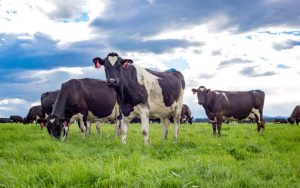
Some frequently asked questions about dairy products:
WHY ARE WE THE ONLY MAMMAL THAT CONTINUES TO DRINK MILK AFTER WEANING?
We are different from other mammals in many ways and have acquired some superior virtues largely through food. About 10,000 years ago, man went from hunting and gathering exclusively to farming and raising livestock. Through an evolutionary process, humans acquired the ability to digest milk throughout life beyond breastfeeding.
Over the centuries, humans learned to transform milk, both to preserve it for longer and to vary its forms of consumption. Thus, dairy products such as yogurt and cheese began to appear. The ability to digest lactose in adulthood spread rapidly to various regions of the world, mainly in areas with a greater tradition of pastoralism: Europe, the Middle East and Africa, as opposed to others such as Asia, where this practice was not common. Today, more than 2 billion people are lactose tolerant.
IS IT ESSENTIAL TO INCLUDE MILK IN OUR DAILY DIET?

In general, 3 daily servings of dairy products are recommended, which provide more than half of the necessary calcium. Depending on the stage of life, this recommendation may be even higher. In addition, milk and dairy products are also a good source of proteins of high nutritional quality and of vitamins B and D. Different scientific institutions have agreed on recommendations for the consumption of milk and dairy products, based on studies that have proven their health benefits[1].
In Spain, 66% of the population consumes less than 2 dairy products per day, so that almost 70% do not reach the recommended intake of calcium[2]. For the main scientific nutrition societies there is no reason to exclude milk and dairy products from the diet in the general population. “There is the idea that a diet free of milk and dairy products does not pose a problem when it comes to reaching the recommended intakes of calcium and vitamin D, and this is a complete mistake: according to our Western dietary model, the exclusion of dairy products prevents reaching the reference intakes for all age groups,” said prof. Gregorio Varela on the occasion of the presentation of the report “Milk as a vehicle for health: calcium and its determinants in the health of the Spanish population”[3], prepared by the Spanish and Ibero-American Nutrition Foundations.
IS MILK ONLY FOR CHILDREN?
Breastfeeding is the most complete nutrition for the baby[4]. When this is not possible, adapted starter or follow-on infant formulas are used. Milk remains the staple food after the age of one year because it represents about 40% of the infant’s diet. Spanish pediatricians have repeatedly reminded us of the importance of maintaining milk and not substituting it with vegetable drinks or other alternatives (except in cases of allergies and intolerances; consult your pediatrician), as this can lead to nutritional imbalances and a negative impact on proper growth and development.
In later stages, there is usually a decrease in the consumption of dairy products as the growing season is considered to be over. However, milk continues to be necessary in adulthood due to its high content of calcium, phosphorus, proteins and vitamins, and the difficulty in reaching the recommendations of these nutrients through other foods. Current scientific evidence, based on the study of the consumption of milk and dairy products in cohorts of hundreds of thousands of people, as well as randomized intervention studies, indicates that the appropriate consumption of these products is beneficial at all ages. Very recently it has been published that dairy consumption is associated with a lower risk of mortality and cardiovascular events such as coronary heart disease, heart attack, heart failure and stroke in the prospective study PURE (Prospective Urban Rural Epidemiology), which includes more than one hundred and thirty thousand subjects aged 35-70 years from 21 countries on five continents.
DOES MILK HAVE AS MUCH NUTRITIONAL VALUE AS CLAIMED?

Milk is considered a basic and balanced food, which provides a high nutrient content in relation to the caloric content, i.e., an excellent nutritional density. The nutritional value of milk is greater than the sum of all its components, which is explained by its particular balance of nutrients.
Milk and dairy products are very valuable foods from a nutritional point of view, providing numerous nutrients, high quality proteins and compounds beneficial to health. Dairy products are the main sources of calcium and vitamin B2, are among the top three sources of protein, vitamin A, vitamin B12, vitamin D and zinc, and also provide significant amounts of vitamin B6, phosphorus, potassium and iodine.
Milk and dairy products are complete foods that contribute to a balanced diet with a good balance of carbohydrates, proteins, vitamins, minerals and fats. It is difficult to achieve an adequate intake of nutrients in diets with low dairy consumption.
DOES MILK CONTRIBUTE MANY CALORIES AND FAT, AFFECTING WEIGHT CONTROL?
There is a false belief that dairy products provide excessive calories and fat. However, they do not contribute more calories or fat than other foods. In fact, in the Spanish diet, dairy products account for 12% of the total calories ingested and 14% of the fat.
As far as their impact on weight control is concerned, studies show that there is no increase in weight when increasing dairy consumption, and some studies have even found benefits in fat loss (when following low-calorie diets and if dairy consumption is increased to the recommended intake).
IS MILK BAD FOR YOU?
If we appeal to scientific research, this only happens to people with some lactose intolerance and, for those cases, there is also milk without it, which already incorporate this natural pre-digested sugar.
Although it is true that there are people allergic to milk, in these cases, the allergy is to its proteins and, in general, it occurs in children under one year of age. In most cases, the symptoms appear when artificial breastfeeding is initiated, generally after a prolonged period of breastfeeding. Even so, the rate is very low: between 1 and 2 % of the infant population. Moreover, only 15% of children who suffer from it maintain it after the age of 6 years. So this does not mean that milk as a whole creates these intolerances or allergies.
IS MILK AND DAIRY TREATED MORE THAN BEFORE?
Today it is common to hear that milk is more treated than before and it is not true. Since the 1950s, manufacturers have been obliged to comply with very strict regulations, starting on the farm and ending when the product is consumed.
Farmers produce milk from healthy cattle, free of antibiotics and hormone treatments, as this is expressly forbidden by law. When the milk is collected at the farm, it is cooled and transported in tanker trucks at less than 5ºC. At the factory, it is subjected to a very short heating to eliminate possible bacteria, maintaining its original flavor, all its nutritional quality and allowing it to be consumed for longer.
Milk remains a natural food after heat treatment, maintaining its main nutrients. Once opened, milk should be kept cold and consumed as soon as possible.
ARE MILK AND DAIRY PRODUCTS NOT GOOD FOR HEALTH?
Today it is common to read news, with a very alarmist tone and without scientific basis, advising not to consume milk because of its effects on health. They circulate rapidly through the media and social networks, and even health and nutrition professionals have come to assume them as true.
This is how some false beliefs have spread. But is it true that milk causes cancer, snot or increases cardiovascular risk? The scientific evidence makes it clear:
- Milk and snot. The scientific evidence does not show a relationship between milk consumption and the production of mucus.
- Milk and cardiovascular health. The scientific evidence does not show a relationship between milk consumption and increased risk of cardiovascular disease. On the contrary, numerous studies suggest a positive effect.
- Milk and cancer. The vast majority of scientific studies show no relationship between milk consumption and cancer risk.
Scientific evidence has shown that the consumption of milk and dairy products has benefits on:
Bone development and maintenance throughout life, thanks to its high calcium and vitamin D content.
Growth during infancy
In addition, fortified milks can help to:
- The control of cholesterol and hypertension.
- Intestinal transit
- Reaching the recommended daily amount of nutrients more easily.
IS THE DAIRY INDUSTRY UNSUSTAINABLE?

The dairy industry is making rapid progress in the creation and implementation of best practices to promote greater environmental sustainability.
First, it is committed to reducing its carbon footprint at all stages of the food production cycle. This initiative covers everything from the farm, collaborating with farmers to detect areas for improvement, to transportation, both for milk collection and for supplying customers, and especially its industrial activity through the advancement of energy efficiency and the increasing use of renewable energies. Likewise, it is working on the search for new materials and improvements in the design of all those containers that are made available to the consumer, with the aim of preserving food quality and safety and minimizing the impact.
Faced with this challenge, they already have industries that will reduce their emissions by 10%, which will prevent the atmosphere from receiving 26,950 tons of CO2 per year. This is equivalent to taking more than 11,000 vehicles off the road for a year. At the same time, milk and cheese processing plants are working on the progressive decarbonization of their industrial activity through photovoltaic installations on the roofs or grounds of their plants.
Local and sustainable production is another priority. For this reason, the industries are committed to a sustainable and local farm management model. They offer training in good practices and advice to provide them with tools to improve their quality of life in order to ensure generational replacement.
In the resource optimization plan, the industries have been making a great effort for years to reduce energy and water consumption. Among the notable advances, the objectives set for the 2015-2020 environmental cycle have been achieved and exceeded. Such is the case of the 20% reduction in CO2 emissions, the 20% reduction in water and electricity consumption, reaching 50% use of rPET (recycled plastic), reaching 100% recyclable or reusable packaging and zero recoverable waste to landfill.
Last but not least, with regard to social sustainability, the company is committed to generating employment and wealth in those territories where it is present, especially in rural areas, where the factories and livestock farmers with which it collaborates are located.
Agriculture and livestock farming in the European Union are among the most efficient and advanced in the world in terms of the commitment of its producers and cooperatives to climate and environmental issues. The sector is working to achieve the major environmental objectives, in balance with economic and social sustainability. Spain, in particular, is a European powerhouse with more than 20,600 dairy farmers.
✅ At eDairy Market we have all the dairy categories, all the products and all the companies. We represent you.
✅ Power your business through eDairy Market:
- Your microsite with products, brand and domain of your company at a minimum cost.
- You will be able to sell your products and we do not charge you commission per sale.
- Now you can sell your Products, Ingredients and Dairy Machinery in English, Spanish, Portuguese and Mandarin Chinese.
✅ Create your own online store in a super easy way:

























